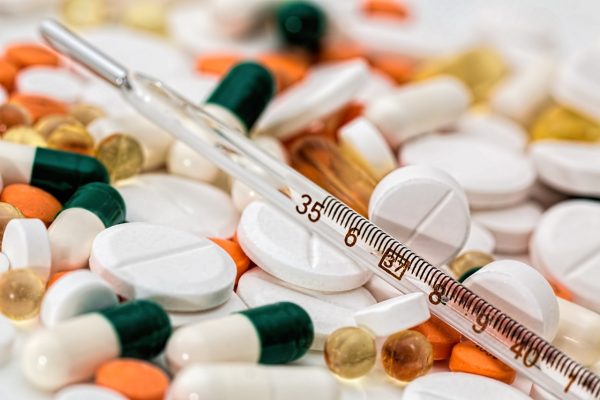A whole generation or multiple generations of doctors have literally been brainwashed into reaching for a prescription pad with likely zero training in likely or putative cross issues. what do you thin will happen soon enough..
Unless the primary caregiver is wide awake and checking, bad things happen. So even in this example, just where was that person? A nurse can tell looking at the tasb type that the med has changed somehow. We actually rely on the doctor getting it right, then we rely on the pharmcist getting it right and then we do rely on a famiy member or the patient getting it right.
Pretty good in practise but here the pharmcist got it wrong by not checking the history which should have instantly alerted them to the issue and obviously patient care was also asleep. Understand that they all are trained better than this.
None of this stops the problem of too many overlapping prescritions. That is way too like trying to find a real problem.
When Prescriptions Harm You
Doctors are often directed in how to treat specific conditions, and all too often those protocols are based around pills. (Tim Masters/Shutterstock)
https://www.theepochtimes.com/when-prescriptions-harm-you_4639067.html?
It is a universal fact that prescriptions, by suppressing or enhancing certain biological pathways, induce unnatural effects in the body. Every single drug added to our regimen, increases the risk of an adverse effect by 7 to 10 percent.
However, this thought rarely crosses our minds when we take a painkiller to numb a headache or an antacid for heartburn. Most of the time we do not need to be concerned about it, especially when taking a generic drug for short-term use.
The problems come when we start taking many medications, for a long time.
Emerging research on prescriptions has found that prescriptions could be leading causes of deaths in the United States.
A study released in 2014 suggested that prescriptions were the third leading causes of deaths in the United States and Europe. Other studies found that prescriptions were causing more deaths than strokes, making them the fourth leading cause of deaths in the United States.
The primary causes of morbidity and mortality from prescriptions are polypharmacy—medication overload—and medical errors, such as errors in prescription and administration of medication.
A study described a case where a 71-year-old woman was wrongfully prescribed an antipsychotic medication (Navane) rather than her usual antihypertensives (Norvasc) for three months. The pharmacist mixed the two names up and she experienced severe adverse changes to her mental health after she unknowingly made the switch.
The Food and Drug Administration (FDA) estimates that it receives up to 100,000 reports of suspected drug errors every year. Other studies suggest that annual medication errors are behind 7,000 to 9,000 mortalities and $40 billion in healthcare costs every year.
Despite such alarming numbers, errors from dispensaries remain a rare occurrence, taking up 2.1 percent of all prescriptions. The rate of adverse effects from errors in administration is even lower.
Though few studies have compiled the prevalence and far-reaching effects of various pharmaceutical errors, polypharmacy (using five or more medications), on the other hand, is one of the most well-researched areas in prescription-involved adverse effects.
Hospitalizations from polypharmacy have been increasing across Europe and in the United States.
However, pharmaceutical adverse effects have received little media coverage with no study yet to examine the full scope of prescription-involved adverse effects.
Polypharmacy: The Interactions Between Drugs and Their Effects on the Body
A single drug can easily come with 20 to 40 side effects and when prescribed with other drugs, may interact with them in unpredictable ways.
However, most physicians prescribing these drugs will not know all of the side effects, nor will they have a full understanding of possible adverse effects from drug interactions.
Dr. Peter C. Gøtzsche likened the problem of drug-to-drug interactions with a pilot faced with various buttons in a cockpit in his study.
“Imagine that airline pilots had thousands of little buttons in the cockpit at their disposal and, furthermore, that those buttons interacted in unpredictable ways if several were switched on simultaneously, analogous to a patient who is on several drugs.”
Prescriptions work by blocking or enhancing certain proteins and receptors. These proteins and receptors perform specific tasks and are often involved in major biological pathways.
Some pathways are well-studied, some are not, which is why side effects of different drugs vary.
Different drugs can induce additive or opposing effects by interfering with each other.
Two drugs may both share an affinity for the same receptor, but induce different effects and inhibit each other’s activity. Likewise, some drugs may induce the same effect by binding to the receptor, therefore creating a larger response than expected.
Some drugs may create a synergistic effect, where the drugs produce a combined effect greater than the sum of their separate effects.
Not just drugs, supplements, food, and a patient’s own conditions can also interfere with the entire process of the drug.
Aging is a major factor that affects drug performance and often slows down drug clearance. Older patients are therefore at a greater risk of drug toxicity and adverse effects.
(Pixabay / Pexels)
Polypharmacy and Adverse Drug Effects
Prescriptions are commonplace and more people are overloading themselves with medication.
Studies show that between 1999 and 2000, 6.3 percent of the U.S. population used 5 or more prescriptions but by 2007 to 2008, this number had reached 10.7 percent.
Older people are especially at risk of polypharmacy.
Studies show that in 2005 to 2006, 53 percent of older adults had polypharmacy (taking 5 or more prescriptions), this number increased to 67 percent from 2010 to 2011.
However, experts believe these numbers are underestimations of the real polypharmacy rates. Many older patients also take supplements and other drugs themselves. They may not tell their doctors about it and many doctors also do not ask.
With age comes increased complaints of chronic and acute conditions as well as visits to the doctor. Each appointment visit also—more often than not—results in prescriptions.
In fact, the modern healthcare system is geared towards prescriptions and polypharmacy.
A 1971 study estimated that 75 percent of all doctor visits result in a prescription. This is because most patients expect a prescription at the end of appointments; they believe that modern medicine should provide an antidote for every symptom, according to authors.
“The prescription is a tangible end to the office visit, and may be perceived by the patient as having greater value than education or reassurance,” the authors of a study wrote.
Over 50 years later, with a bigger and growing pharmaceutical market, and marketing campaigns that target both patients and doctors, it is likely that this mentality has only been strengthened.
Polypharmacy also gives rise to many adverse drug effects and drug induced injuries.
A study found that with every addition to the regimen, the risk of adverse effects increases. When taking two medications, the risk of an adverse event is 13 percent, this number increases to 58 percent when taking five drugs. In patients taking seven or more medication, this risk surpasses 80 percent.
Another 2019 report estimated that polypharmacy would result in 150,000 premature American deaths and more than 4.6 million hospitalizations over the next decade.
“[Medication overload] will reduce the quality of life for millions more. Strong, coordinated, and immediate action is needed to stem the tide of this epidemic, which harms people of all ages, but especially older generations,” the authors of the report wrote.
Polypharmacy in the older demographic has been associated with increased falls which can often result in a broken hip. Broken hips increase the risks of death due to the the various complications that come after a broken hip, including stroke, pneumonia, dementia, and so on.
Drugs that affect the central nervous system (the brain and the spinal cord) may also induce overdoses and death.
Though the exact healthcare burden from polypharmacy has not been calculated, research suggests that health care expenditures may be doubled due to polypharmacy.
A study on patients with cardiovascular diseases found that polypharmacy almost doubled health care expenditure.
(wavebreakmedia/Shutterstock)
The Challenge of Deprescription
The healthcare system is geared towards polypharmacy, but sufficient interventions to “deprescribe” is not put in place to counter medication overload.
Physicians are more educated about prescribing than stopping medications.
Textbooks on pharmacotherapy tell doctors when to start drugs, but unless adverse drug reactions arise, doctors are not taught when and if they should stop.
Therefore patients may use the same prescription for years, even when it is no longer necessary.
Medical books on reducing polypharmacy also often place discontinuation of medications as the last recommendation.
Another confounding factor in polypharmacy, especially in older patients, is that doctors and patients may mistake adverse drug effects from the prescription as signs of diseases instead. Therefore, rather than stopping the medication, another prescription is added to the regimen, leading to a “polypharmacy cascade.”
Signs of polypharmacy include loss of appetite, diarrhea, tiredness, confusion and hallucinations, weakness and dizziness, skin rashes, depression, anxiety, and excitability.
How to Avoid Prescription-Induced Harm
To reduce harm from prescriptions, Gøtzsche recommended that prior to purchase, patients should search the package insert for drug side effects.
Most drugs come with 20 to 40 side effects, and patients cannot expect their doctors to know all of them.
Some websites also offer drug interaction checkers where patients can submit the prescriptions they are taking. Though the majority of drug interactions have low morbidity, in rare cases it can cause severe debilitating effects and even death.
Emerging studies also warn patients not to use newly released medications.
Most physicians will recommend that newly released medications—unless they are “breakthrough” medications, meaning that they are better than drugs already on the market—should be avoided in the first 5 to 7 years after release.
However, the vast majority of new drugs (80 percent or more) released every year are “me too” drugs rather than “breakthroughs.” “Me too” drugs are new modifications to generic drugs and generally do not work much better than drugs already on the market.
Dr. Donald W. Light wrote that newly released medications are generally some of the most unreliable, and unsafe medications.
With accelerated approval and increased drug applications, drug approvals are becoming less reliable. Regulators, including the FDA, have also transitioned to regulate drugs through post-market surveillance rather than performing rigorous investigations prior to approval.
Studies found that most drugs that are withdrawn for safety reasons are often withdrawn in the first 7 years after market approval. Another study on 222 drugs released from 2001 to 2010, found that one third of these new drugs were alerted, warned, or recalled by the FDA a few years after release.
Depending on what you and your healthcare practitioner discuss, some herbal remedies might be more helpful than certain medications. (Shutterstock)
Increased Interest in Homeopathic Medicines
In the light of drug adverse effects, the use of alternative medicines including homeopathic medicines has steadily increased.
The root of polypharmacy and many prescription-induced problems stem from allopathic medicine, the basis of conventional western medicine.
Western medicine is not curative, rather it operates to resolve the symptoms of the disease by providing a “quick fix,” often leaving the root of the ailment festering in numbed silence.
Though patients may see an immediate effect on their symptoms, the unnatural effects of prescriptions can easily lead to side effects which can then call for more prescriptions.
Homeopathy, on the other hand, provides an alternative direction in medical practice. Practitioners of homeopathy examine the whole body in treating the patient, aiming to use as few prescriptions as possible by making the body better able to respond to disease.
Homeopathic doctors tend to advise patients on changes in lifestyles and habits to restore homeostasis to the body. This reduces risks of drug toxicity from pharmaceuticals, offering natural interventions as compared to unnatural ones.
Nonetheless, neither concept of medicine is perfect. Homeopathy has been discouraged by many western doctors due to lacking in solid evidence of having prominent benefits to a patient.
The effects of homeopathy can be slower than allopathy, and in the case of severe chronic diseases such as diabetes and cancer, patients practicing homeopathy may take a long time to see any benefits if at all.
The argument between homeopathy or allopathy among different medical ideologies is a long standing debate but both have their own benefits in treating patients.
Views expressed in this article are the opinions of the author and do not necessarily reflect the views of The Epoch Times. Epoch Health welcomes professional discussion and friendly debate. To submit an opinion piece, please follow these guidelines and submit through our form here.




No comments:
Post a Comment